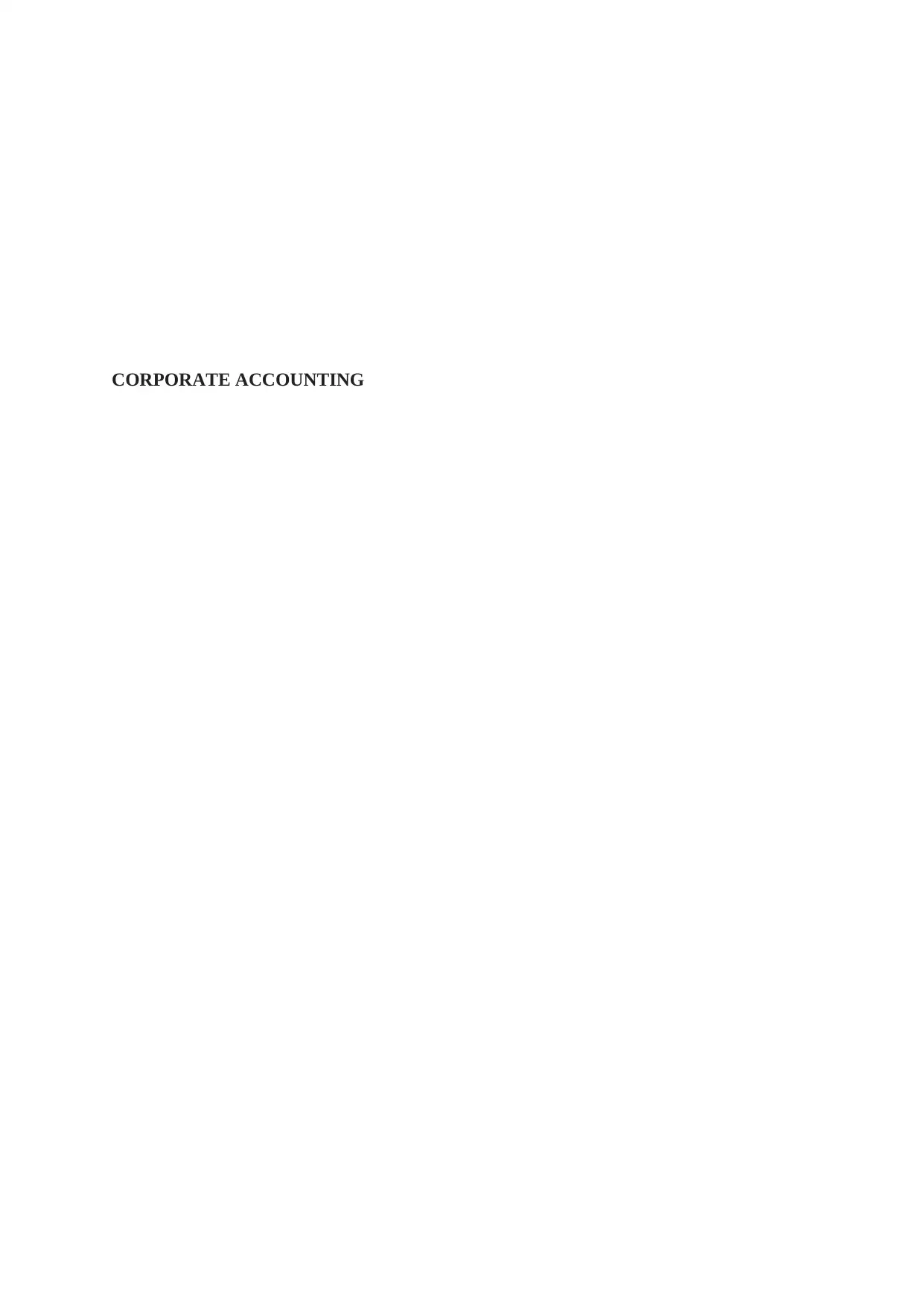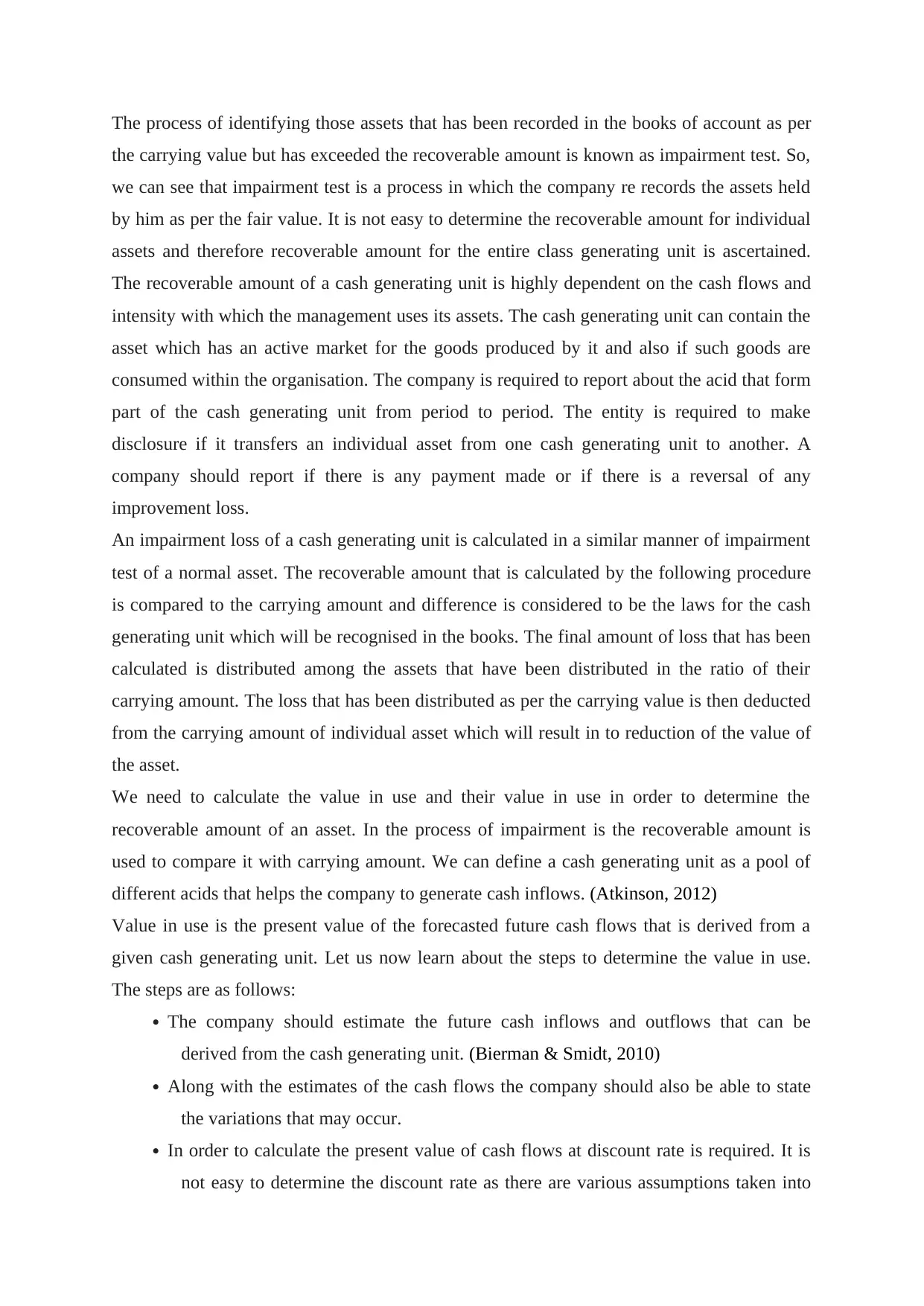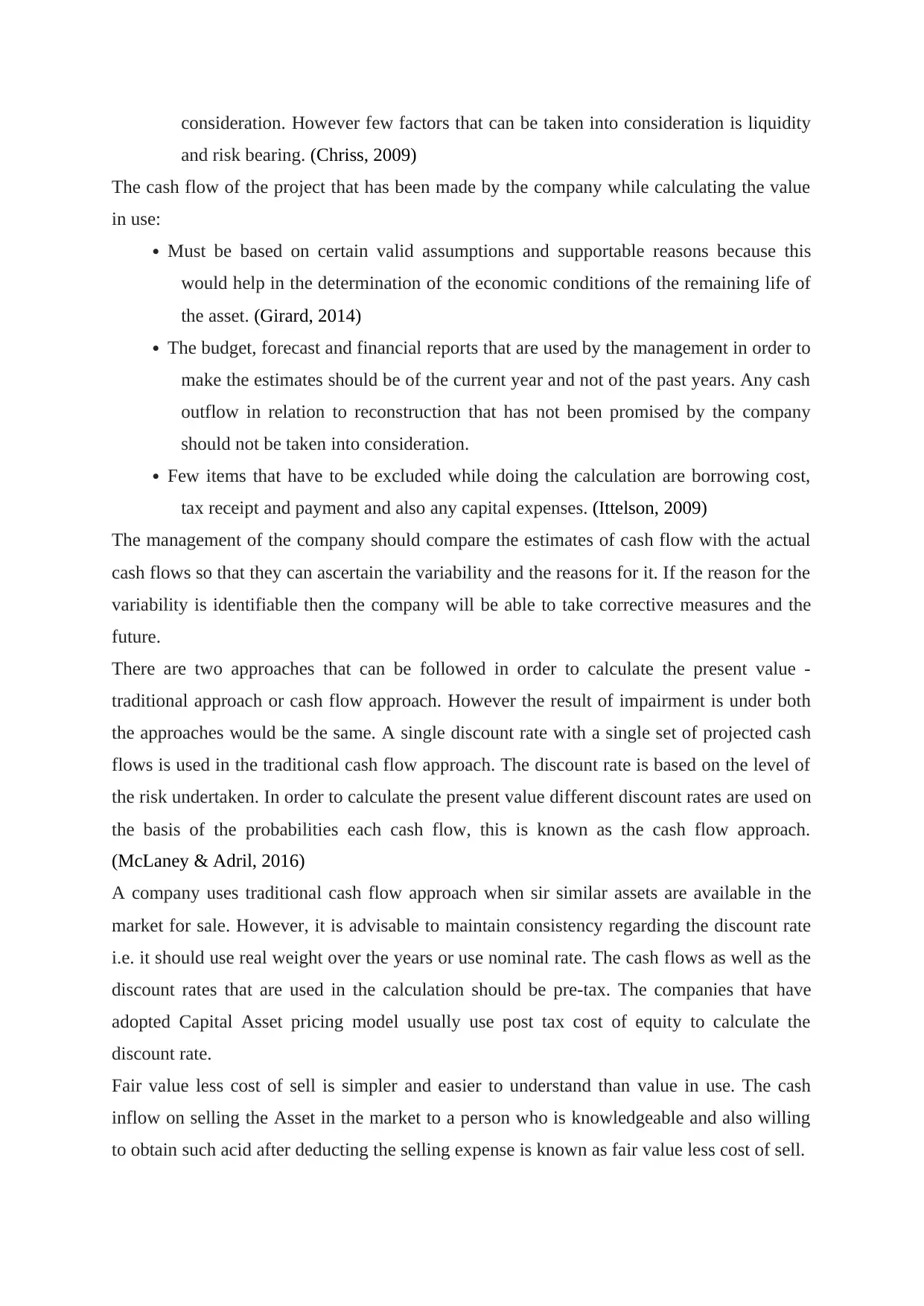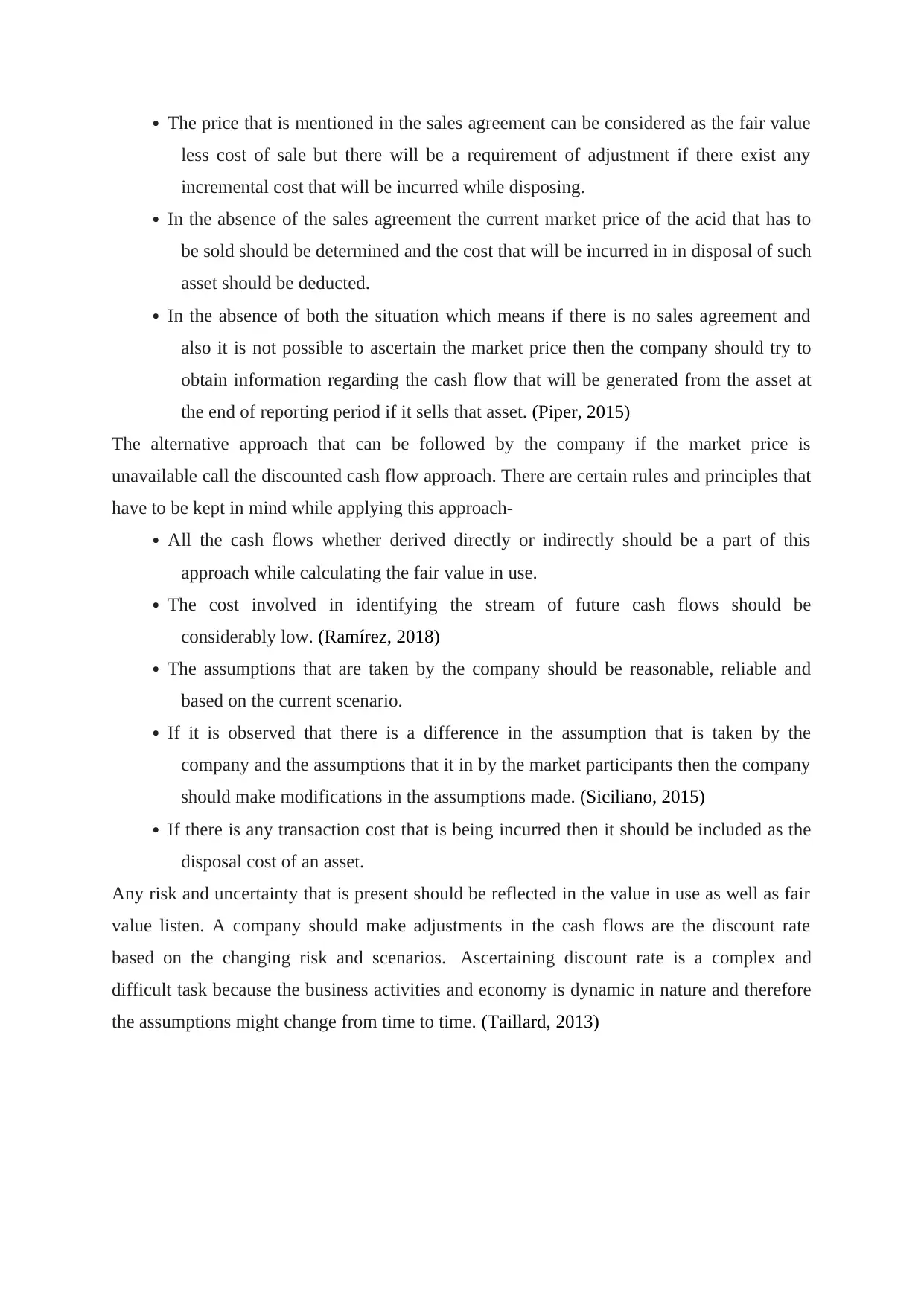BO1COAC318 Corporate Accounting: Comprehensive Impairment Test Report
VerifiedAdded on 2023/06/11
|5
|1600
|223
Report
AI Summary
This report provides a detailed analysis of impairment testing in corporate accounting, focusing on the process of identifying assets recorded at carrying value that exceed their recoverable amount. It explores the complexities of determining recoverable amounts for individual assets versus cash-generating units, emphasizing the importance of cash flows and management's asset utilization. The report covers the steps involved in calculating value in use, including estimating future cash flows, considering variations, and determining appropriate discount rates. It also discusses the traditional and cash flow approaches to present value calculation, highlighting the significance of valid assumptions and consistent discount rates. Furthermore, the report contrasts value in use with fair value less cost of sell, outlining methods for determining fair value in different market scenarios and emphasizing the need for reasonable assumptions and risk adjustments. This analysis provides a comprehensive understanding of impairment testing and its application in corporate accounting.

CORPORATE ACCOUNTING
Paraphrase This Document
Need a fresh take? Get an instant paraphrase of this document with our AI Paraphraser

The process of identifying those assets that has been recorded in the books of account as per
the carrying value but has exceeded the recoverable amount is known as impairment test. So,
we can see that impairment test is a process in which the company re records the assets held
by him as per the fair value. It is not easy to determine the recoverable amount for individual
assets and therefore recoverable amount for the entire class generating unit is ascertained.
The recoverable amount of a cash generating unit is highly dependent on the cash flows and
intensity with which the management uses its assets. The cash generating unit can contain the
asset which has an active market for the goods produced by it and also if such goods are
consumed within the organisation. The company is required to report about the acid that form
part of the cash generating unit from period to period. The entity is required to make
disclosure if it transfers an individual asset from one cash generating unit to another. A
company should report if there is any payment made or if there is a reversal of any
improvement loss.
An impairment loss of a cash generating unit is calculated in a similar manner of impairment
test of a normal asset. The recoverable amount that is calculated by the following procedure
is compared to the carrying amount and difference is considered to be the laws for the cash
generating unit which will be recognised in the books. The final amount of loss that has been
calculated is distributed among the assets that have been distributed in the ratio of their
carrying amount. The loss that has been distributed as per the carrying value is then deducted
from the carrying amount of individual asset which will result in to reduction of the value of
the asset.
We need to calculate the value in use and their value in use in order to determine the
recoverable amount of an asset. In the process of impairment is the recoverable amount is
used to compare it with carrying amount. We can define a cash generating unit as a pool of
different acids that helps the company to generate cash inflows. (Atkinson, 2012)
Value in use is the present value of the forecasted future cash flows that is derived from a
given cash generating unit. Let us now learn about the steps to determine the value in use.
The steps are as follows:
The company should estimate the future cash inflows and outflows that can be
derived from the cash generating unit. (Bierman & Smidt, 2010)
Along with the estimates of the cash flows the company should also be able to state
the variations that may occur.
In order to calculate the present value of cash flows at discount rate is required. It is
not easy to determine the discount rate as there are various assumptions taken into
the carrying value but has exceeded the recoverable amount is known as impairment test. So,
we can see that impairment test is a process in which the company re records the assets held
by him as per the fair value. It is not easy to determine the recoverable amount for individual
assets and therefore recoverable amount for the entire class generating unit is ascertained.
The recoverable amount of a cash generating unit is highly dependent on the cash flows and
intensity with which the management uses its assets. The cash generating unit can contain the
asset which has an active market for the goods produced by it and also if such goods are
consumed within the organisation. The company is required to report about the acid that form
part of the cash generating unit from period to period. The entity is required to make
disclosure if it transfers an individual asset from one cash generating unit to another. A
company should report if there is any payment made or if there is a reversal of any
improvement loss.
An impairment loss of a cash generating unit is calculated in a similar manner of impairment
test of a normal asset. The recoverable amount that is calculated by the following procedure
is compared to the carrying amount and difference is considered to be the laws for the cash
generating unit which will be recognised in the books. The final amount of loss that has been
calculated is distributed among the assets that have been distributed in the ratio of their
carrying amount. The loss that has been distributed as per the carrying value is then deducted
from the carrying amount of individual asset which will result in to reduction of the value of
the asset.
We need to calculate the value in use and their value in use in order to determine the
recoverable amount of an asset. In the process of impairment is the recoverable amount is
used to compare it with carrying amount. We can define a cash generating unit as a pool of
different acids that helps the company to generate cash inflows. (Atkinson, 2012)
Value in use is the present value of the forecasted future cash flows that is derived from a
given cash generating unit. Let us now learn about the steps to determine the value in use.
The steps are as follows:
The company should estimate the future cash inflows and outflows that can be
derived from the cash generating unit. (Bierman & Smidt, 2010)
Along with the estimates of the cash flows the company should also be able to state
the variations that may occur.
In order to calculate the present value of cash flows at discount rate is required. It is
not easy to determine the discount rate as there are various assumptions taken into

consideration. However few factors that can be taken into consideration is liquidity
and risk bearing. (Chriss, 2009)
The cash flow of the project that has been made by the company while calculating the value
in use:
Must be based on certain valid assumptions and supportable reasons because this
would help in the determination of the economic conditions of the remaining life of
the asset. (Girard, 2014)
The budget, forecast and financial reports that are used by the management in order to
make the estimates should be of the current year and not of the past years. Any cash
outflow in relation to reconstruction that has not been promised by the company
should not be taken into consideration.
Few items that have to be excluded while doing the calculation are borrowing cost,
tax receipt and payment and also any capital expenses. (Ittelson, 2009)
The management of the company should compare the estimates of cash flow with the actual
cash flows so that they can ascertain the variability and the reasons for it. If the reason for the
variability is identifiable then the company will be able to take corrective measures and the
future.
There are two approaches that can be followed in order to calculate the present value -
traditional approach or cash flow approach. However the result of impairment is under both
the approaches would be the same. A single discount rate with a single set of projected cash
flows is used in the traditional cash flow approach. The discount rate is based on the level of
the risk undertaken. In order to calculate the present value different discount rates are used on
the basis of the probabilities each cash flow, this is known as the cash flow approach.
(McLaney & Adril, 2016)
A company uses traditional cash flow approach when sir similar assets are available in the
market for sale. However, it is advisable to maintain consistency regarding the discount rate
i.e. it should use real weight over the years or use nominal rate. The cash flows as well as the
discount rates that are used in the calculation should be pre-tax. The companies that have
adopted Capital Asset pricing model usually use post tax cost of equity to calculate the
discount rate.
Fair value less cost of sell is simpler and easier to understand than value in use. The cash
inflow on selling the Asset in the market to a person who is knowledgeable and also willing
to obtain such acid after deducting the selling expense is known as fair value less cost of sell.
and risk bearing. (Chriss, 2009)
The cash flow of the project that has been made by the company while calculating the value
in use:
Must be based on certain valid assumptions and supportable reasons because this
would help in the determination of the economic conditions of the remaining life of
the asset. (Girard, 2014)
The budget, forecast and financial reports that are used by the management in order to
make the estimates should be of the current year and not of the past years. Any cash
outflow in relation to reconstruction that has not been promised by the company
should not be taken into consideration.
Few items that have to be excluded while doing the calculation are borrowing cost,
tax receipt and payment and also any capital expenses. (Ittelson, 2009)
The management of the company should compare the estimates of cash flow with the actual
cash flows so that they can ascertain the variability and the reasons for it. If the reason for the
variability is identifiable then the company will be able to take corrective measures and the
future.
There are two approaches that can be followed in order to calculate the present value -
traditional approach or cash flow approach. However the result of impairment is under both
the approaches would be the same. A single discount rate with a single set of projected cash
flows is used in the traditional cash flow approach. The discount rate is based on the level of
the risk undertaken. In order to calculate the present value different discount rates are used on
the basis of the probabilities each cash flow, this is known as the cash flow approach.
(McLaney & Adril, 2016)
A company uses traditional cash flow approach when sir similar assets are available in the
market for sale. However, it is advisable to maintain consistency regarding the discount rate
i.e. it should use real weight over the years or use nominal rate. The cash flows as well as the
discount rates that are used in the calculation should be pre-tax. The companies that have
adopted Capital Asset pricing model usually use post tax cost of equity to calculate the
discount rate.
Fair value less cost of sell is simpler and easier to understand than value in use. The cash
inflow on selling the Asset in the market to a person who is knowledgeable and also willing
to obtain such acid after deducting the selling expense is known as fair value less cost of sell.
⊘ This is a preview!⊘
Do you want full access?
Subscribe today to unlock all pages.

Trusted by 1+ million students worldwide

The price that is mentioned in the sales agreement can be considered as the fair value
less cost of sale but there will be a requirement of adjustment if there exist any
incremental cost that will be incurred while disposing.
In the absence of the sales agreement the current market price of the acid that has to
be sold should be determined and the cost that will be incurred in in disposal of such
asset should be deducted.
In the absence of both the situation which means if there is no sales agreement and
also it is not possible to ascertain the market price then the company should try to
obtain information regarding the cash flow that will be generated from the asset at
the end of reporting period if it sells that asset. (Piper, 2015)
The alternative approach that can be followed by the company if the market price is
unavailable call the discounted cash flow approach. There are certain rules and principles that
have to be kept in mind while applying this approach-
All the cash flows whether derived directly or indirectly should be a part of this
approach while calculating the fair value in use.
The cost involved in identifying the stream of future cash flows should be
considerably low. (Ramírez, 2018)
The assumptions that are taken by the company should be reasonable, reliable and
based on the current scenario.
If it is observed that there is a difference in the assumption that is taken by the
company and the assumptions that it in by the market participants then the company
should make modifications in the assumptions made. (Siciliano, 2015)
If there is any transaction cost that is being incurred then it should be included as the
disposal cost of an asset.
Any risk and uncertainty that is present should be reflected in the value in use as well as fair
value listen. A company should make adjustments in the cash flows are the discount rate
based on the changing risk and scenarios. Ascertaining discount rate is a complex and
difficult task because the business activities and economy is dynamic in nature and therefore
the assumptions might change from time to time. (Taillard, 2013)
less cost of sale but there will be a requirement of adjustment if there exist any
incremental cost that will be incurred while disposing.
In the absence of the sales agreement the current market price of the acid that has to
be sold should be determined and the cost that will be incurred in in disposal of such
asset should be deducted.
In the absence of both the situation which means if there is no sales agreement and
also it is not possible to ascertain the market price then the company should try to
obtain information regarding the cash flow that will be generated from the asset at
the end of reporting period if it sells that asset. (Piper, 2015)
The alternative approach that can be followed by the company if the market price is
unavailable call the discounted cash flow approach. There are certain rules and principles that
have to be kept in mind while applying this approach-
All the cash flows whether derived directly or indirectly should be a part of this
approach while calculating the fair value in use.
The cost involved in identifying the stream of future cash flows should be
considerably low. (Ramírez, 2018)
The assumptions that are taken by the company should be reasonable, reliable and
based on the current scenario.
If it is observed that there is a difference in the assumption that is taken by the
company and the assumptions that it in by the market participants then the company
should make modifications in the assumptions made. (Siciliano, 2015)
If there is any transaction cost that is being incurred then it should be included as the
disposal cost of an asset.
Any risk and uncertainty that is present should be reflected in the value in use as well as fair
value listen. A company should make adjustments in the cash flows are the discount rate
based on the changing risk and scenarios. Ascertaining discount rate is a complex and
difficult task because the business activities and economy is dynamic in nature and therefore
the assumptions might change from time to time. (Taillard, 2013)
Paraphrase This Document
Need a fresh take? Get an instant paraphrase of this document with our AI Paraphraser

Bibliography
Atkinson, A. A. (2012). Management accounting. Upper Saddle River, N.J.: Paerson.
Bierman, H., & Smidt, S. (2010). The Capital Budgeting Decision. Boston: Routledge.
Chriss, N. A. (2009). Black-Scholes and beyond. New York: McGraw-Hill.
Girard, S. L. (2014). Business finance basics. Pompton Plains, NJ: Career Press.
Ittelson, T. (2009). Financial Statements: A Step-by-Step Guide to Understanding and
Creating Financial Reports. Franklin Lakes, N.J.: Career Press.
McLaney, E., & Adril, D. P. (2016). Accounting and Finance: An Introduction. United
Kingdom: Pearson.
Piper, M. (2015). Accounting made simple. United States: CreateSpace Pub.
Ramírez, C. Z. (2018). The Impact of IFRS 16 on Key Financial Ratios: A New
Methodological Approach. Accounting in Europe .
Siciliano, G. (2015). Finance for Nonfinancial Managers. New York: McGraw-Hill.
Taillard, M. (2013). Corporate finance for dummies. Hoboken, N.J.: Wiley.
Atkinson, A. A. (2012). Management accounting. Upper Saddle River, N.J.: Paerson.
Bierman, H., & Smidt, S. (2010). The Capital Budgeting Decision. Boston: Routledge.
Chriss, N. A. (2009). Black-Scholes and beyond. New York: McGraw-Hill.
Girard, S. L. (2014). Business finance basics. Pompton Plains, NJ: Career Press.
Ittelson, T. (2009). Financial Statements: A Step-by-Step Guide to Understanding and
Creating Financial Reports. Franklin Lakes, N.J.: Career Press.
McLaney, E., & Adril, D. P. (2016). Accounting and Finance: An Introduction. United
Kingdom: Pearson.
Piper, M. (2015). Accounting made simple. United States: CreateSpace Pub.
Ramírez, C. Z. (2018). The Impact of IFRS 16 on Key Financial Ratios: A New
Methodological Approach. Accounting in Europe .
Siciliano, G. (2015). Finance for Nonfinancial Managers. New York: McGraw-Hill.
Taillard, M. (2013). Corporate finance for dummies. Hoboken, N.J.: Wiley.
1 out of 5
Related Documents
Your All-in-One AI-Powered Toolkit for Academic Success.
+13062052269
info@desklib.com
Available 24*7 on WhatsApp / Email
![[object Object]](/_next/static/media/star-bottom.7253800d.svg)
Unlock your academic potential
Copyright © 2020–2025 A2Z Services. All Rights Reserved. Developed and managed by ZUCOL.




